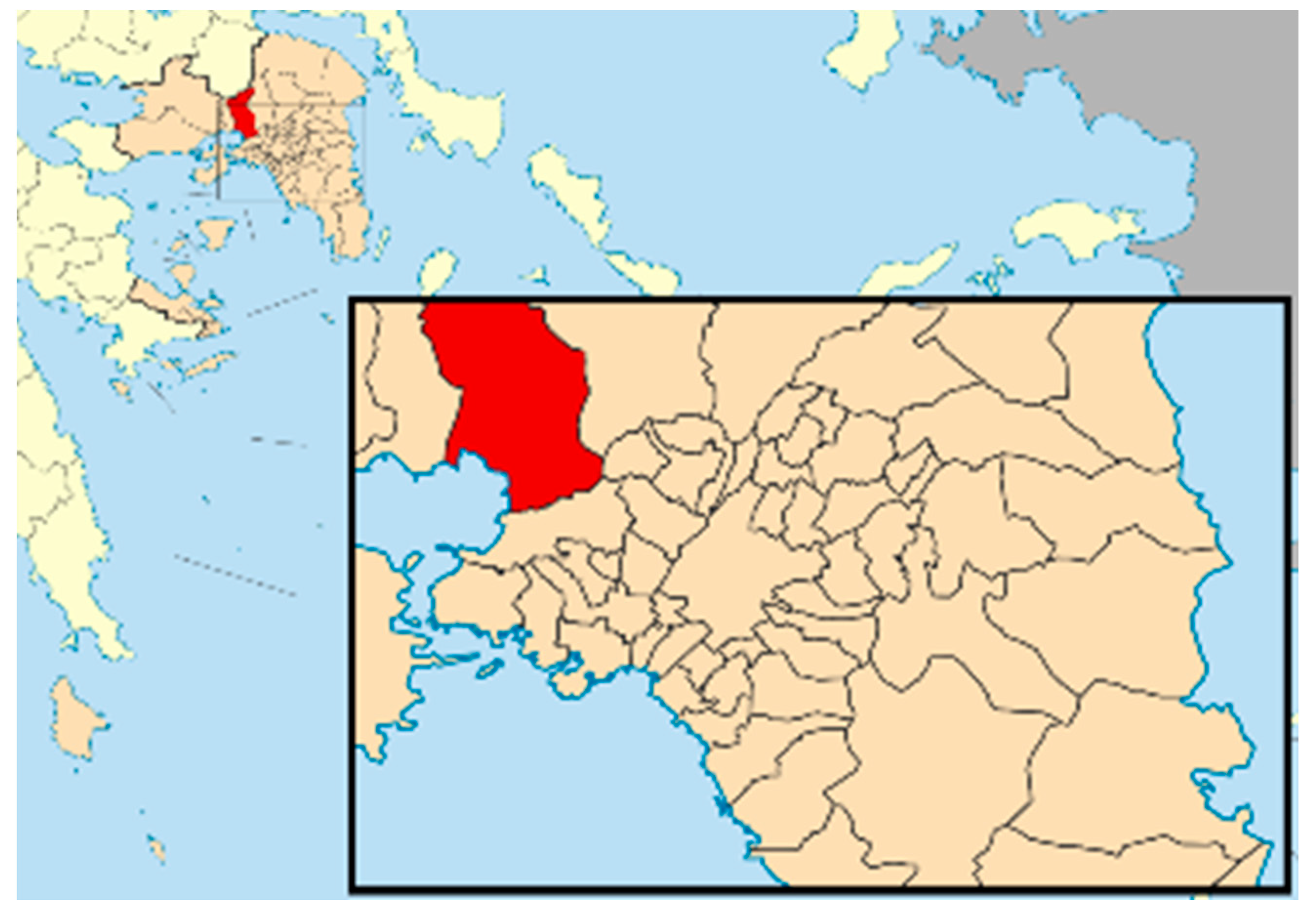Water Quality and Energy Consumption in Peri-Urban Agriculture: Lessons Learnt from a Real Case Study in a Municipality Close to Athens †
Abstract
:1. Introduction
2. Materials and Methods
2.1. Modern Tools: Water and Energy Issues in Precision Irrigation in Agriculture
2.2. Characteristics of a Peri-Urban Area: Peri-Urban Agriculture and Challenges
2.3. Water Quality Issues in Aspropyrgos
3. Data and Results
Case Study: Precision Irrigation and Water-Energy Nexus in the Pilot Field
4. Discussion and Conclusions
Author Contributions
Funding
Informed Consent Statement
Data Availability Statement
Acknowledgments
Conflicts of Interest
References
- Stylianopoulou, K.G.; Papapostolou, C.M.; Kondili, E.M. Water-Energy-Food Nexus: A focused review on integrated methods. Environ. Sci. Proc. 2020, 2, 46. [Google Scholar] [CrossRef]
- Cui, S.; Wu, M.; Huang, X.; Wang, X.; Cao, X. Sustainability and assessment of factors driving the water-energy-food nexus in pumped irrigation systems. Agric. Water Manag. 2022, 272, 107846. [Google Scholar] [CrossRef]
- Peng, W.; Zheng, H.; Robinson, B.E.; Li, C.; Li, R. Comparing the importance of farming resource endowments and agricultural livelihood diversification for agricultural sustainability from the perspective of the food-energy-water nexus. Clean. Prod. 2022, 380, 135193. [Google Scholar] [CrossRef]
- Bwambale, E.; Abagale, F.K.; Anornu, G.K. Smart irrigation monitoring and control strategies for improving water use efficiency in precision agriculture: A review. Agric. Water Manag. 2022, 260, 107324. [Google Scholar] [CrossRef]
- Savvas, D. General Horticulture; Pedio Publishing: Athens, Greece, 2016; pp. 461–486. ISBN 978-960-546-782-1. (In Greek) [Google Scholar]
- Lalakis, G. An outdoor crop monitoring system based on wireless sensors. Bachelor’s Thesis, Technological Institute of Crete, Crete, Greece, 2019. (In Greek). [Google Scholar]
- Opitz, I.; Berges, R.; Piorr, A.; Krikser, T. Contributing to food security in urban areas: Differences between urban agriculture and peri-urban agriculture in the Global North. Agric. Hum. Values 2016, 33, 341–358. [Google Scholar] [CrossRef]
- Zasada, I. Multifunctional peri-urban agriculture-A review of societal demands and the provision of goods and services by farming. Land Use Policy 2011, 28, 639–648. [Google Scholar] [CrossRef]
- Dimoulea, A.E. Sustainability strategies for peri-urban agriculture: The case of West Attica. Master’s Thesis, Agricultural University of Athens, Athens, Greece, 2018. (In Greek). [Google Scholar]
- Karampela, A.; Karampatou, A. Urban observatory in the Municipality of Aspropyrgos. Bachelor’s Thesis, Technological Educational Institute of Piraeus, Athens, Greece, 2019. (In Greek). [Google Scholar]





Disclaimer/Publisher’s Note: The statements, opinions and data contained in all publications are solely those of the individual author(s) and contributor(s) and not of MDPI and/or the editor(s). MDPI and/or the editor(s) disclaim responsibility for any injury to people or property resulting from any ideas, methods, instructions or products referred to in the content. |
© 2023 by the authors. Licensee MDPI, Basel, Switzerland. This article is an open access article distributed under the terms and conditions of the Creative Commons Attribution (CC BY) license (https://creativecommons.org/licenses/by/4.0/).
Share and Cite
Santi, D.; Papapostolou, C.M.; Ktenidis, P. Water Quality and Energy Consumption in Peri-Urban Agriculture: Lessons Learnt from a Real Case Study in a Municipality Close to Athens. Environ. Sci. Proc. 2023, 26, 183. https://doi.org/10.3390/environsciproc2023026183
Santi D, Papapostolou CM, Ktenidis P. Water Quality and Energy Consumption in Peri-Urban Agriculture: Lessons Learnt from a Real Case Study in a Municipality Close to Athens. Environmental Sciences Proceedings. 2023; 26(1):183. https://doi.org/10.3390/environsciproc2023026183
Chicago/Turabian StyleSanti, Dionysia, Christiana M. Papapostolou, and Panagiotis Ktenidis. 2023. "Water Quality and Energy Consumption in Peri-Urban Agriculture: Lessons Learnt from a Real Case Study in a Municipality Close to Athens" Environmental Sciences Proceedings 26, no. 1: 183. https://doi.org/10.3390/environsciproc2023026183
APA StyleSanti, D., Papapostolou, C. M., & Ktenidis, P. (2023). Water Quality and Energy Consumption in Peri-Urban Agriculture: Lessons Learnt from a Real Case Study in a Municipality Close to Athens. Environmental Sciences Proceedings, 26(1), 183. https://doi.org/10.3390/environsciproc2023026183






